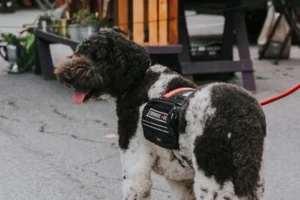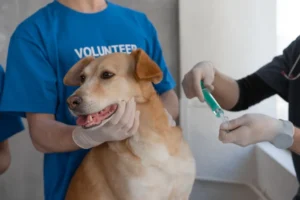
Understanding the irritation of jumping through hoops trying to legitimize your service dog? You’re in the right place. This post promises to guide you through getting your service dog certified and give you a clear idea of the costs involved.
Quick Takeaways:
- Service dog certification is not legally required but can provide valuable ID for your dog, proving their training and role.
- Costs can vary: $10,000-$30,000 for professional training programs or a few thousand for DIY, plus under $100 for registration fees.
- Key steps involve assessing your dog’s suitability, professional or self-training, passing a public access test, and obtaining optional certification and registration.
What is a Service Dog Certification?
Service dog certification is like a passport for your pooch, proving that they’re more than just a pet—they’re a furry friend with a serious job. Unlike the average dog, a certified service dog has the legal recognition to go places pets typically can’t, like restaurants, stores, and airplanes. This certification isn’t just a fancy title; it’s a testament to the dog’s training and demeanor, ensuring they’re equipped to assist their handler in specific ways, whether that’s pulling a wheelchair, alerting to a medical issue, or providing emotional support.
Why’s it a big deal, you ask? For starters, it helps differentiate your trained helper from the growing crowd of pets in “service dog” vests bought online. This distinction upholds the integrity of real service dogs and protects the rights of individuals who genuinely rely on these animals. Plus, it emphasizes the dog’s role in providing essential support, ensuring both the handler and the dog are treated with the respect they deserve in public spaces.
How Do You Get Your Dog Certified as a Service Dog?
Getting your dog certified as a service dog isn’t as daunting as it sounds, but it does require commitment and patience. Here’s a straightforward guide to lead you through the process:
-
Assess Your Dog’s Suitability : Not every dog is cut out to be a service dog. The ideal candidate is calm, adaptable, and responsive to training. Age and breed matter less than temperament.
-
Identify Your Needs : Service dogs can be trained for a variety of disabilities, including physical, sensory, psychiatric, intellectual, or other mental disabilities. Knowing the specific tasks you need assistance with will guide your training plan.
-
Professional Training : This is where the magic happens. You have two paths: train the dog yourself or enroll them in a professional service dog program. Training includes obedience, performing specific tasks to aid the handler, and public access skills. It’s crucial to document this training process thoroughly.
-
Public Access Test : A key step that’s often overlooked is passing a public access test. It’s not universally required but highly recommended. This test evaluates the dog’s behavior in public—ensuring they’re not a menace or distraction to others.
-
Certification and Registration : Though not legally required in the United States, registering your service dog with a reputable organization can provide a handy form of ID. Look for entities that adhere to the American Disabilities Act (ADA) guidelines.
Pro Tip: For those training their service dogs independently, consider seeking a mentor in the service dog community. An experienced handler can offer invaluable advice and insight that you won’t find in textbooks.
How Much Does it Cost to Certify a Service Dog?
The cost to certify a service dog can vary widely depending on several factors, including whether you choose professional training or go the DIY route. Here’s a breakdown of potential costs:
-
Professional Training Programs : These can run anywhere from $10,000 to $30,000. This hefty price tag covers comprehensive training tailored to your specific needs. Programs like these often boast high success rates due to their experience and resources.
-
DIY Training : If you decide to train your service dog, costs might include training materials, classes, and possibly hiring a professional trainer for guidance, which could sum up to a few thousand dollars. Don’t forget the public access test, which might cost around $150.
-
Certification and Registration : Fees for registering your service dog with a reputable organization are typically modest, often less than $100. This usually includes an ID card, certificate, and sometimes a vest.
Remember, while there are upfront costs to training and certifying a service dog, the independence and support they provide can be life-changing. Additionally, investing in proper training ensures your service dog will be a respected and welcome helper wherever you go.
Investing in a service dog is more than just paying for a pet; it’s investing in your independence and quality of life. While the journey to certification may seem complex, the rewards of having a loyal companion by your side, ready to assist with your specific needs, are immeasurable.
Is There an Official Registry for Service Dogs?
When it comes to registering a service dog, it’s crucial to separate fact from fiction. A common myth that circulates around is the idea of an “official registry” for service dogs. Let’s set the record straight – there is no federal or state-mandated registry for service dogs in the United States. This might come as a surprise to many, given the number of websites claiming to offer official registration or certification. The truth is, these sites are not recognized by any governmental authority and are not necessary under the law.
The Americans with Disabilities Act (ADA) does not require service dogs to be registered or certified. What it emphasizes is the dog’s ability to perform specific tasks or work directly related to the person’s disability. So, if you stumble upon websites offering to list your service dog in an “official database” for a fee, know that these are not required and don’t carry weight under the law. It’s crucial to navigate this landscape equipped with the right knowledge to avoid unnecessary expenses and focus on what genuinely matters – the training and well-being of your service dog.
What Documentation is Needed for Service Dog Certification?
When we talk about service dog certification, it’s important to understand the documentation that is actually beneficial and in some cases, necessary. While there’s no need for an “official” certification or registry, there are pieces of documentation that you might find invaluable, especially when accessing public spaces or traveling. Here’s what you should have:
- Proof of Training: Documentation from a reputable training program that states your dog has been trained as a service dog. This could include a detailed training log or a letter from a professional trainer.
- Health Records: Keeping a copy of your dog’s vaccination and health records is always a good idea. These can come in handy during travel or when accessing certain public spaces.
- Doctor’s Note: For certain situations, like housing or air travel, you might need a letter from a healthcare provider stating that you have a disability and that your service dog provides support related to your disability.
Remember, while these documents are not a legal requirement everywhere, they can greatly simplify your life and the acceptance of your service dog in various scenarios.
Can Any Dog Become a Service Dog?
Wondering if your furry friend has what it takes to be a service dog? It’s not just about the dog’s breed or size but more about their temperament and capabilities. Here are the key traits and characteristics that are essential for a dog to successfully undertake service dog work:
- Temperament: A service dog should be calm, adaptable, and not easily startled. They must show patience and the ability to focus amid distractions.
- Trainability: Not all dogs are keen on learning or capable of performing specific tasks. A good service dog candidate is eager to learn with a strong desire to please.
- Socialization: Service dogs need to be well-socialized. They should be comfortable around various people, environments, and other animals without showing aggressive or fearful behavior.
- Health and Age: A service dog must be in good health and typically, it’s easier to train young dogs, although adult dogs can also be trained successfully.
Here’s a unique tip that’s rarely discussed but immensely helpful: Engage in ‘Public Access Training’. Beyond the basic obedience and task-specific training, introduce your dog to a variety of public settings gradually. This type of training ensures your dog can behave impeccably in diverse environments – from restaurants to airplanes. Documenting this training can also serve as valuable proof of your dog’s capabilities.
In essence, the journey to having a certified service dog involves understanding the law, preparing the right documentation, and ensuring your dog has the qualities and training to provide genuine assistance. Armed with this knowledge, navigating the world with your service dog can be a smooth and rewarding experience.
Alex, a passionate animal lover, has experience in training and understanding animal behavior. As a proud pet parent to two dogs and three cats, he founded AnimalReport.net to share insights from animal experts and expand his knowledge of the animal kingdom.










I just like the helpful information you provide in your articles